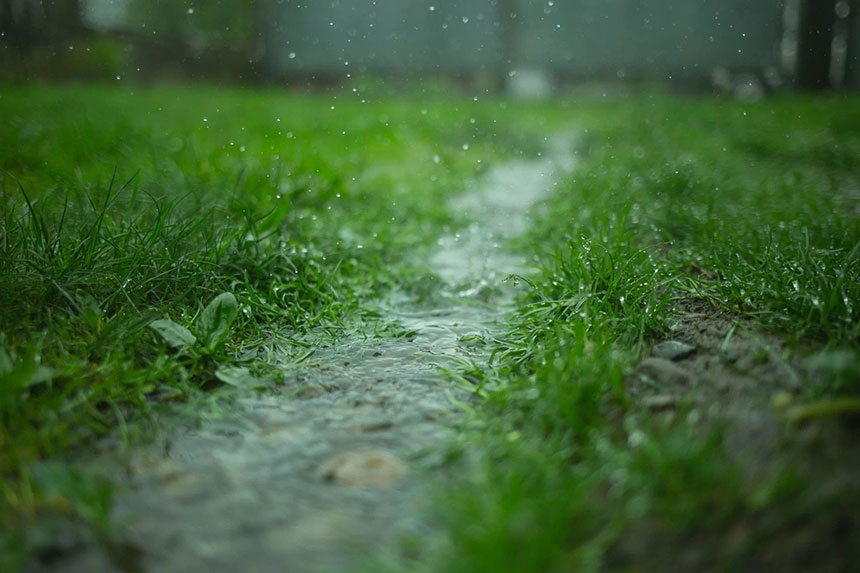After a downpour, you go and look out to see the glorious green grass wet and thriving in your glorious garden. But wait… ”Where are they?” you wonder, because all you see, sadly, in your lawn is water.
Does water sit in your lawn for hours, or worse, days, after a heavy rainfall? Your lawn most probably has a drainage problem, and that’s why it’s waterlogging. Good drainage should be a crucial prerequisite if you want your garden plants and lawn grass to grow healthy. But you don’t have to worry if your lawn has drainage issues. You have ways to fix it so your garden is rain- and flood-ready in the future.
Congrats (NOT)! You Have a Waterlogged Lawn
When it rains too much, your lawn reaches a point where the soil struggles to absorb any more water and gets saturated to a certain extent that it becomes waterlogged.
Waterlogging occurs when there is too much water in a plant’s root zone, which decreases the oxygen available to roots. It can be a major constraint to the growth and production of your plants. Unfortunately, under certain conditions, waterlogging may also kill your plants.
Your lawn has a drainage problem when:
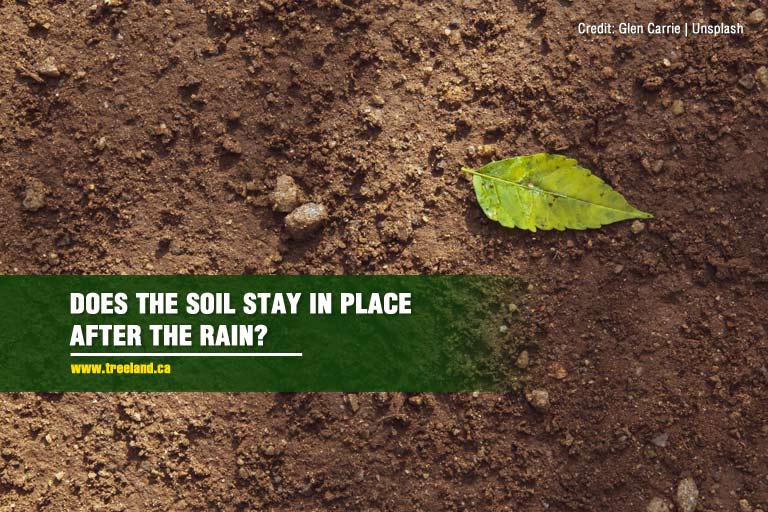
- The soil in your lawn is eroding. You may see signs of erosion around your lawn in the form of fissures or pits in the soil and areas where the soil appears to have dropped.
- The topsoil moves every time it rains. When the water is not absorbed by the soil, or if it doesn’t have a clear drainage path, it will wash over the topsoil and mulch in your lawn.
- Water pools under gutters and downspouts. If your gutters are clogged, you will see water flooding over your gutters and start to pool around your foundation.
- Your wood floor is warping. If your lawn doesn’t have an adequate drainage system, it can cause water to go into your crawlspace. Excess moisture into your crawl space can cause your wood floor to warp.
- Your crawl space has puddles or soggy areas. When you see that your crawl space is infested with pests, it’s most likely because puddles of water are forming, which in turn, proves that you may be having problems with your lawn drainage.
- Random overgrown patches of grass start showing up. Where there’s too much water, there’s too much life. When you see patches of grass that stand out like a sore thumb in your lawn, this may be an indication that the drains in your garden aren’t working well to your advantage.
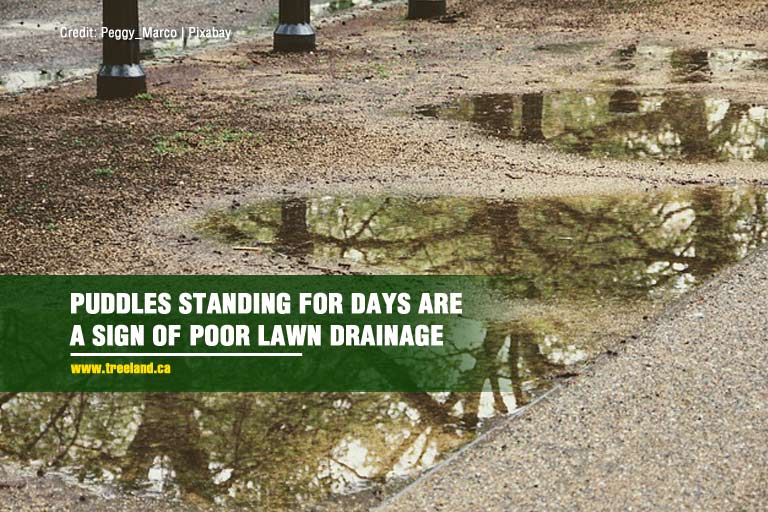
- There are large puddles of pooling or standing water. Large puddles of pooling or standing water show that the soil you are using for your lawn is not absorbing the water and that your lawn drainage is not working to drain water in your backyard.
- You find water stains on the foundation of your home. Water stains on the foundation of your home indicate that water is starting to flood over your gutters.
Identifying the Source of Your Lawn Drainage Problem
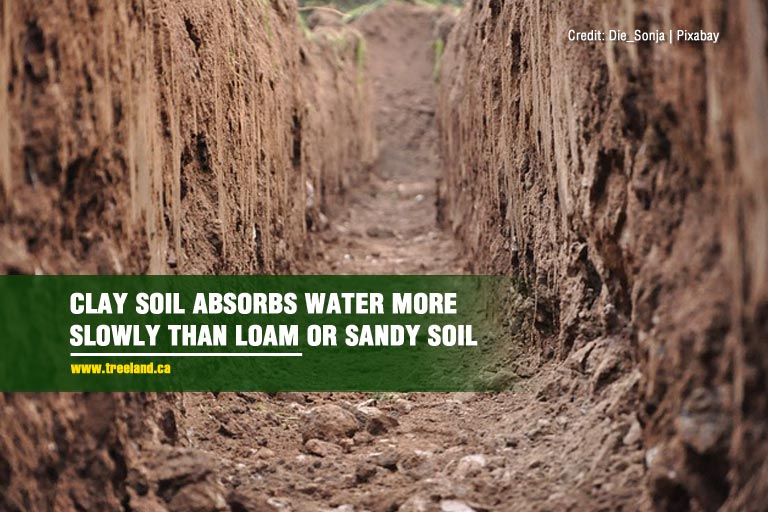
Knowing why your backyard drain is having some issues allows you to determine the right remedy. Some common causes of backyard drainage issues are:
- Compacted soil (lawn drainage problems are imminent when the soil contains lots of clay)
- Improper backyard grading and sloping
- Poorly maintained eavestrough and downspouts
- Improper installation of landscape features like a fence or deck
Understanding your lawn drainage problems is the first step to fixing them. Start by observing how water gets into your lawn, and how it flows or sits. Drainage does not happen instantly, so rainwater is never completely absorbed immediately by the soil. Roots can create a thick barrier that can greatly reduce soil permeability.
The two important issues relating to lawn drainage are:
- Soil permeability
Compaction makes the soil almost impenetrable. This does not only cause your drainage problem but also cuts off the flow of air to sustain the living soil below. This is a recurring problem for lawns with clay soil, as it is denser than sandy or loam soil and absorbs water relatively slower.
- Lawn topography
When water falls onto the soil and fails to penetrate it, it runs down to wherever gravity may pull it. When that happens, the water gets trapped if it reaches an area with poor drainage. So if you notice that your grass is surrounded by water, it may be that the water is trapped.
The general shape of your lawn should drive water away from your house and lawn naturally. Make sure that you form your lawn in a way that drains water naturally.
What Happens If I Don’t Fix This?
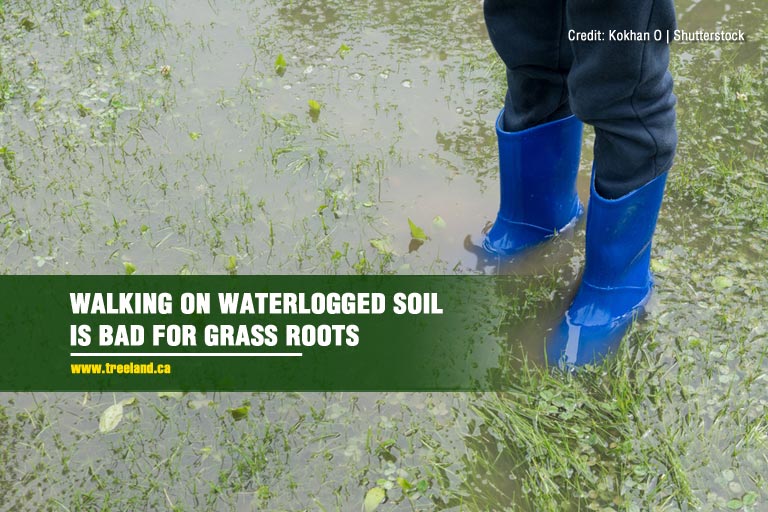
There are many side effects if you choose not to fix your drainage problems. Here are just a few:
- Most plants are not adapted to water-clogged soils. So when you plant grass for your lawns, you need to have a drainage system that supports the growth of grass in your garden. Most trees and shrubs are also not adapted to growing in water-saturated soils, and too much water leads to their lack of oxygen.
- You can’t enjoy your lawn, let alone walk on it comfortably until the water has completely dried — which can take days. Walking on a wet lawn is heavily discouraged because it can cause soil compaction, which hinders the roots of your plants from penetrating deep into the soil. Plus, getting mud on your feet defeats the purpose of going out for a leisurely walk.
- A large puddle of pooling or standing water attracts mosquitoes, which you don’t really want on your lawn. Even if the water stays on your lawn for only 2 days, it is long enough for mosquito eggs to hatch. Beyond the annoying biting and itchiness, these mosquitoes may be carriers of the deadly West Nile virus.
- A puddle of sitting water close to the foundation of your house is also a big problem since it can slowly seep into your walls and can cause cracks and mould.
- The biggest side effect of a poor drainage system is property damage. Without a good drainage system, you risk the following:
- Erosion
- Insect and rodent infestations
- Mould growth and wood rot
- Overflowing gutters
- Basement water stains
- Foundation and structural damage
- Building material deterioration
- Damage to concrete and asphalt
No More Waterlogging: Here’s What You Can Do
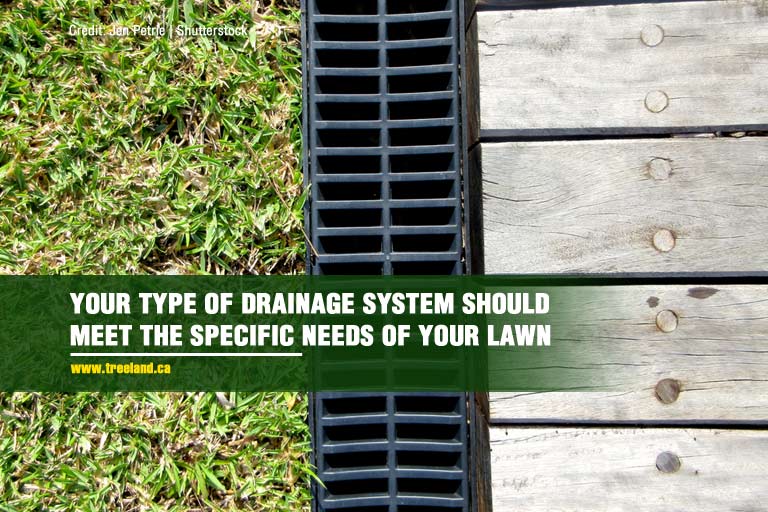
Drainage problems in your lawn can cause your backyard to flood, ruin your grass and gardens, and may even leave your backyard unusable. If you have a drainage issue, there are simple things that you can do to fix it.
- Aeration
Aeration for your lawn will help improve the drainage and will add air into the soil. Grass roots are also improved with aerators. You can aerate your lawn either by spiking the lawn with a garden fork or aerator shoes or by using a hollow tine aerator. The best aeration tool will depend on the severity of waterlogging, and the type of soil that is in your lawn.
Regularly aerating the soil in your lawn is essential throughout the spring and summer months to help minimize the compaction of the soil, which will in turn help to minimize waterlogging in the winter and autumn.
- Digging a french drain
Having a french drain installed in your backyard is the most viable solution if the waterlogging is severe, although this will likely involve professionals, heavy machinery, and some major garden overhaul and upheaval. This can also come in handy after a storm when you need to drain so much water in your backyard.
Installing a french drain will help surface water to run away from the problem area.
- Pricking, slitting or spiking
Pricking or slitting the lawn surface with shallow holes can help garden drainage, but deeper spiking is even better. These holes can be filled with free-draining material to allow the water to flow from the surface to deeper, less compacted layers.
- Choosing permeable paths and patios
Choose pathways and patio surfaces that will allow the water to easily soak in. This will help prevent the water from running off onto the grass, which makes waterlogging worse. The most permeable are shingle or bark pathways, so explore if you have those options.
- Digging a ditch
Digging a ditch at the lowest point allows water to run and sit somewhere it won’t do any damage to your lawn. However, digging a ditch is not always a suitable suggestion for every garden. Depending on the size of your garden, you could dig a ditch and even turn it into a pond.
- Growing more plants
One of the easiest and best ways to improve the drainage in your garden is simply to grow more plants. It is also an inexpensive solution. In the long run, these plants will also make for a more attractive garden.
However, plant choice is also important, as you would want to choose plants that can survive in dry and wet conditions. For optimum results, choose native plants and landscaping trees that are known to withstand the most extreme conditions in your area.
- Building raised beds
Building raised plant beds means that you can fill them with good quality, free-draining topsoil. You can construct these raised beds out of timber railway sleepers or brickwork.
- Improving soil drainage
If your drainage issues are not severe, you can improve the permeability of the soil in your beds, which will alleviate your drainage problem. To do this, you’ll need to dig in organic matter, as soil with a high organic matter content allows excess water to drain through. However, if your soil is sticky and clay-like, it’s advisable to add coarse grit sand to aid drainage.
- Managing surface water
A great way to improve drainage is to manage surface water run-off effectively and efficiently. What you need to do is incorporate sloping surfaces within your garden so that the excess water is directed to an area where it can be disposed of.
However, this can be costly and you’ll need to hire a mini excavator to sculpt the contours of your garden. If you choose this option, make sure to seek professional advice.
- Installing land drains
Installing land drains involves digging a trench in your lawn, fixing a perforated land drain, and then re-covering, so this option is generally only recommended if your drainage issues are particularly bad.
How Much Does it Cost to Install a Lawn Drainage System?

The drainage system in your lawn depends on the specifics of your lawn: the landscape, the proximity to your house, your type of soil and grass, among other factors. In Canada, these are the estimated price ranges for the 3 most common lawn drainage systems installed in landscapes:
- A simple 75 ft long French drain can cost between $4,000 and $6,000. Additional complications and specifications to the system, such as length, obstacles, and distance to discharge zone, can bring the costs to $10,000/$20,000.
- A perimeter and downspout drain system around a 40 ft x 50 ft residential home can cost between $10,000 and $50,000. The more complications to the system, the higher the price.
- Lawn regrading (sloping the ground away from your home and other structures) costs between $3,000 and $4,000. This applies to a 5000 sq. ft. lawn but may cost more if your landscape is larger in size.
Costs definitely vary between companies, so make sure to talk to your landscaping service of choice so you can explore your lawn drainage system options. While the prices all look costly, a lawn drainage system is definitely a good investment for your home, especially if you live under climate conditions that run the risk of flooding your area in most parts of the year.
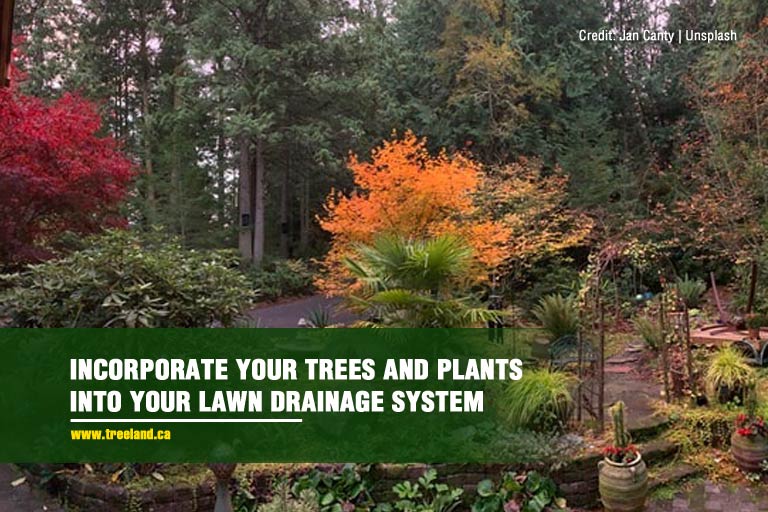
We know there’s no quick fix to a waterlogged lawn, but landscaping trees sure can help. Not only do our evergreen and shade trees add beauty to your surroundings, but they can also contribute to a better lawn drainage system. If you’re in the GTA, call Caledon Treeland via (905) 880-1828 or email treeland@treeland.ca to set an appointment now!

